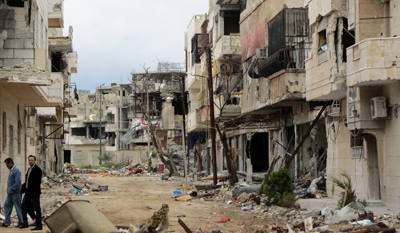When the story is so important but the risks are so high, journalists must keep safety at the forefront of their thinking. That’s especially true for freelancers who often do not have the support of a large news organization. Preparation, peer networking, and smart planning can help improve the odds of not only surviving hostile situations but succeeding in one’s work.
Earlier last year, I went with a small team of journalists into the besieged Syrian city of Homs and spent three days inside the Baba Amr district, where I witnessed some of the devastation. Working in an area that was bombarded daily and was running out of supplies, journalists faced an intense challenge just moving a short distance to conduct an interview or to film the destruction. After three days, we made the decision to leave amid signs that government forces were planning to move in.
Not long after returning, I held a training session for a group of freelance journalists from around the United States. The training was aimed at giving them information and practical, hands-on skills to manage their next hazardous assignment. We decided to use our recent assignment in Syria as a focus for the training and to highlight the subtle changes in the risks that we saw.
During the sessions, which were set in a wooded area of Tennessee, we used a farm as a mock-media house where the journalists were living and working. The first two days were largely academic as we introduced journalists to situational awareness, weapon identification, and trauma medical training. The latter half of the training included practical scenarios in which they were placed in a simulated Syrian combat zone. We sought to give them guidance on risk management, travel security, and ways to respond if they were unfortunate enough to be kidnapped or held against their will.
Freelance journalists typically pursue a story because they are passionate about the subject. Many are also looking for a big break in a field in which it can be difficult to stand out. But that does not mean one has to be unprepared or ill-equipped. My firm is among a growing number of groups that are providing security training for journalists, especially reporters and photojournalists who work freelance. The CPJ Journalist Security Guide identifies a number of organizations that provide security training and support. In addition, the Rory Peck Trust provides a wide variety of support for freelancers.
The important thing is this: Seek out advice, get as much training as possible, and prepare fully before heading out into the field. In a dangerous environment, the only predictable thing is that a hostile event will occur–often at the worst time. By planning a trip as much as possible, one can minimize the risk, identify possible dangers, and have the flexibility to deal with diverse situations. Establishing contacts, networking with peers, and researching the destination can help make an assignment more successful.
Much of the preparation can be boiled down to common-sense steps. Don’t over-pack, make sure you have all the appropriate documentation, and ensure someone responsible knows where you are going and what you are doing and what to do if something goes wrong.
So what if something does go wrong? Situations often arise where journalists are injured while caught in crossfire or if combatants target them. It’s important to know how to handle a situation requiring medical assistance; in most cases, lives can be saved with items carried in your backpack such as a basic medical kit. Carry the items and know how to use them under pressure.
Training, knowledge, and preparation will not only help you survive, but they will help you tell the story better.
